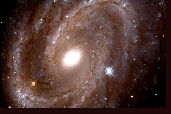
|
Astronomy Briefly brought to you by Duane Dunkerson |
 |
|
|
|
||||||
| The Astronomer's Diet - Big
Macs, no UV and hold the CIS
Malnutrition, Urocanic Acid, and Sun May Interact to Suppress Immunity in Sojourners to High Altitude. D. H. Hug, J. K. Hunter, and D. D. Dunkerson. Aviation, Space, and Environmental Medicine, Volume 72, Number 2, February 2001. This article, which is a stepping stone to another one now in press, relates the potential interaction of urocanic acid (UCA), the sun's ultraviolet radiation, and malnutrition. This interaction could be a concern of those who are transients at high altitude (HA). Such temporary visitors to HA include astronomers who, in some cases, are frequently at higher altitudes because that is where their telescopes and other instruments perform best. The interaction of UCA,UV, and malnutrition is a three part component of a proposed suppression for the immune system. It all starts with the histidine. Histidine is one of the essential amino acids. It is necessary to consume foods containing enough histidine for a healthy diet. Acquiring one's intake of histidine is not usually difficult to do. More difficult would be to keep histidine out of a normal diet. Histidine is present in the skin. It is transported to the skin via blood flow. Histidine in the skin is transformed into UCA through action of an enzyme, histidine, contained in the skin. Most often, another enzyme, urocanase, breaks down the UCA. As it happens, there is no urocanase in the skin. The UCA so formed is called trans-UCA. If trans-UCA is exposed to the sun's UV, the trans-UCA is photoisomerized, that is, the trans-UCA has, on average, about 50% of itself changed into cis-UCA by the UV energy it absorbs. The cis-UCA has been "implicated", as they say, in the start of suppression of immunity. It is proposed that if one is exposed for a period to a lack of a protein diet, while UV strikes the skin, the already mentioned UCA conversion to cis-UCA is exacerbated. Such a worsening of one's condition is brought on by an increase in histidine at the skin because usually HA visitors eventually do not support a zestful appetite and eat, on balance, food deficit in protein. This leaves out what is required to breakdown histidine and UCA. One gets an increase in histidine and UCA and even more UCA gets UV-converted to cis-UCA. This UV can be intense at the higher altitudes. Some observatories, for example, are high above sea level. The terrestrial UV environment includes such variables as altitude, scattered UV, ozone levels, terrain reflectivity and solar zenith angle. Sunburn from UV increases about 5 to 10% per 1000 meters of altitude. The presence of snow increases the UV exposure since new snow reflects 90% of sunlight incident upon it. Applying sunscreens to the skin are alleged to be very beneficial to prevent high dosages of UV. The effects of properly applied sunscreen are in dispute. Improper application of sunscreens is common. Most think they can allow more exposure to UV if they have on a sunscreen. Most also think there is less UV danger at lower temperatures. In addition, various fabrics have been tested for effectiveness in blocking out UV. There is a variance in protection due to color, type of fiber, and fabric mass. The persistence of cis-UCA on the skin for up to three weeks following a single exposure to UV shows that a potent factor could be at work at high altitude. At an even higher altitude, namely in orbit around the earth, the astronauts may have health problems brought on or worsened by UV radiation. This latter possibility is addressed in a forthcoming article to appear in the Journal of Photobiology and Photochemistry.
|
||||||
|
|
Copyright © 2024 by Duane Dunkerson All Rights Reserved |
|||||
|
|
If you wish,
send me email telling me what you think about these articles, headline; etc. Also if you have a questionrelating to astronomical matters, I can answer it or refer you. |
|||||